 This year’s Sundance Film Festival is over and done with, yet gave the world a healthy crop of films that are likely to splash heavy when released to the general public at some point further down the 2013 line. In my first dispatch from Park City, I lamented and openly questioned the timing of the festival, for one held in the mountainous realm of central Utah during the middle of January is hard on the body, not to mention the pocketbook. Already transitioned into their juicy “winter” prices, the ski resort-town of Park City further ratchets up the tension on their township’s fiscal snare when Sundance comes around each winter.
This year’s Sundance Film Festival is over and done with, yet gave the world a healthy crop of films that are likely to splash heavy when released to the general public at some point further down the 2013 line. In my first dispatch from Park City, I lamented and openly questioned the timing of the festival, for one held in the mountainous realm of central Utah during the middle of January is hard on the body, not to mention the pocketbook. Already transitioned into their juicy “winter” prices, the ski resort-town of Park City further ratchets up the tension on their township’s fiscal snare when Sundance comes around each winter.
Lodging, transportation, and sustenance costs go through a roof already punctured, and what remains is a collection of fifty thousand some-odd folks milling about in a town normally housing less than eight thousand souls. Yet even with this horde of industry piquets, inquisitive journalists, curious civilians, and incognito celebrities, there was something fresh in the air. Indeed, this is why the motley collection just mentioned were all crowded into the frigid confines of Park City in the latter half of January: this festival, Sundance, represents the first cinematic breath of air for every new year.
 THIS is why Robert Redford and his people have kept this damn thing tucked away in the armpit of winter! Each year, bright-eyed indie filmmakers can take their shot at one of North America’s premier platforms for quality cinema; and what’s more, these films have a chance at getting in on that year’s word-of-mouth ground-floor if they become a Sundance “darling.” Like any business, movie-making is about getting something while it’s still fresh, while it’s got that hot reputation ahead of last year’s films still grappling for trophies. For filmmakers, Sundance acts as a veritable Golden Ticket into the chocolate factory, if not for the grand prize, then at least for a tour of a truly magnificent dreamland. For industry and press folk, the trip allows for an inside peek into what’s going to be some of the big-shit names during the coming year: much like a sports scout attending Spring Training, or the Combine. Sundance is the first look of the year, and in 2013, it was indeed an interesting peek.
THIS is why Robert Redford and his people have kept this damn thing tucked away in the armpit of winter! Each year, bright-eyed indie filmmakers can take their shot at one of North America’s premier platforms for quality cinema; and what’s more, these films have a chance at getting in on that year’s word-of-mouth ground-floor if they become a Sundance “darling.” Like any business, movie-making is about getting something while it’s still fresh, while it’s got that hot reputation ahead of last year’s films still grappling for trophies. For filmmakers, Sundance acts as a veritable Golden Ticket into the chocolate factory, if not for the grand prize, then at least for a tour of a truly magnificent dreamland. For industry and press folk, the trip allows for an inside peek into what’s going to be some of the big-shit names during the coming year: much like a sports scout attending Spring Training, or the Combine. Sundance is the first look of the year, and in 2013, it was indeed an interesting peek.
The following is a ranking of the “best” films this particular journalist saw while attending the 2013 Sundance Film Festival, a ranking that was labored over to practically no end. Truly, there was one film (see #10) that didn’t really deserve to be on any kind of “best” anything, yet since this particular reviewer only got to about 15 movies in the seven days spent in Park City, certain concessions needed to be made. Indeed, although it was very well-reviewed, and won the Grand Jury prize for Best Dramatic Feature, I didn’t get a chance to see Fruitvale, which would have likely made it near the front of this list had it not played right on the heels of Big Sur (see #5), which had its Press and Industry screening right before the former film’s. These sorts of things happen at film festivals, which are like music venues of a similar ilk that force a person decide between two headliners of equal draw playing at the same time. For more extended reviews of the films mentioned below, or for some hum-dingers about some movies so wretchedly God-awful that they nearly got a dubious ranking of their own, check out the Scene-Stealers Sundance page here. For now, however…
The perfect example of a one-note film with nothing more than a singular concept from which to draw any propulsion, Halley was at least in good company at Sundance. A number of films suffered from a similar disadvantage, for while they had an interesting idea around which a film COULD be assembled, they never went beyond this one intriguing notion to develop a second or third act, or layered characters capable of leading the one trick pony out of the stable. Other films of this sort at Sundance, like A Teacher and Virtually Heroes, didn’t have concepts quite as intriguing as that found in Halley, however, which was about a man drifting through the agony of a living death. Much like what one might expect from an actual, real-life zombie (just without the brain death and cannibalism), the main character of Halley, Berto (Alberto Trujillo), wandered through the first half of the film dealing with the practical realities of living whilst his body continued to die. Yet there were more questions in Halley than answers, and an overall stench of amateurism in a picture that had the look of a high-end, well-shot feature. The recipient of a very, very generous Swiss Fist rating, Halley just barely sneaked into the ranking, one spot ahead of another small film with its own set of problems, which were altogether different from those found in our #10 place-holder…
The winner of Sundance’s World Cinema Grand Jury Prize, Jiseul stood in stark contrast to films like Halley. Indeed, while Halley and other like it had one interesting, small idea, and little to dress it up with, Jiseul had one huge idea, yet didn’t commit to the development of its smaller details. The story of an uprising that took place in 1948 on the South Korean island of Jeju, Jiseul spoke to not just the story of the aforementioned incident, but also to the need of humans to develop and maintain a community. Whether it was amongst the displaced villagers, huddled in a dark cave, or two soldiers questioning orders that bordered on genocide, the film made a point to show how important it was to be amongst a group: amongst one’s own. To be fair, the picture wasn’t without its fair share of problems, not the least of which were a host of questionable lighting choices paired with a somewhat unwieldy cast the audience never got to know all that well. Still, it was a decent first try, and had plenty of heart, thus giving it a boost into this most hallowed ranking, which saw fit to bestow a little extra attention on another film that took home a prize for its efforts…
The recipient of the Sundance Audience Award for best feature within the “NEXT” category, This Is Martin Bonner took its audience on a very challenging, yet altogether fascinating journey. It followed Paul Eenhoorn as the title character, Martin Bonner, whose lonely, detached, yet decidedly human existence served as a kind of reminder that one day, if we make it that far, we all wake up and find ourselves on the wrong side of fifty. If not very careful, when that rude awakening occurs, one might find themselves living out of boxes inside some low-end studio apartment in Reno, Nevada, talking to one adult child over the phone about her sibling, and why the ungrateful bastard never calls. Yet This Is Martin Bonner never fell into a cliché character moment, and always seemed willing to go a little deeper into the emotional core of those on-screen. Bonner could have easily been some salty, disillusioned bastard hashing out the messy details of a freshly started life thousands of miles away from the one he left behind, but he wasn’t. No, the filmmakers of the picture decided to give their lead some tender humanity, a decision that brought the picture’s second piece, the Travis character (played wonderfully subtle by Richmond Arquette), into better focus. Travis found an unlikely friend in Martin, who wasn’t just some two-dimensional cut-out of the grizzled old man archetype audiences have seen a thousand times before. A very thoughtful, interesting, well-acted film that suffered from a less-than-cohesive and half-assed third act, This Is Martin Bonner was good enough to get a few heads turned (hence its prize), yet it just barely missed out on the #7 spot, which was held down by…
A very textured, symbolically rich film with interesting characters and a unique plot, Houston succeeded on a lot of levels. It starred Ulrich Tukur as German businessman Clemens Trunschka, a corporate head hunter battling both his alcoholism and self-doubt while on a trip to Texas. Intriguing both for what it gave its audience on the surface, but also for the trust it had for them to pick up on what wasn’t, Houston didn’t waste any moments, and used a very simple premise to crank up the tension at a consistent tick. Although it was plagued by a hallow third act, much like a number of the other films listed in this list’s top-half, its characters were more fully developed, and existed in a world entirely recognizable to any viewer. Special mention should again go to actor Garret Dillahunt, who received a heap of justified praise in my original review of Houston. Seriously, the guy about stole the picture out from underneath star Ulrich Tukur. Hey, speaking of Deadwood alums running away with the 2013 Sundance pictures they were in, we ought to spend a moment talking about Calamity Jane’s…err, ah-hem, Robin Weigert’s stunning performance in…
One of the few movies this reviewer felt torn on as far as the specific rock-fist rating, its eventual assignment of a MINOR rock-fist up could have just as easily been a SOLID. Concussion was a damn-fine movie about the no-bullshit responsibilities and pressures of a committed, long-term relationship. Just ask someone who is in one of those, they’ll tell you: it ain’t easy! Especially when kids get involved, and notions of a relationship’s sustainability are subject to the strictures of a child’s emotional well-being, things only gets tougher. This is what Abby (Robin Weigert) realized in Concussion, something that drove her into mid-life crisis, only to emerge once again a seasoned and surprisingly talented call girl. The film took a lot of chances with its characters, for what began as a fairly straightforward exercise in sexual self-discovery turned into a very thoughtful examination of the responsibilities of domestic partnership. Again, the filmmakers seemed a little unsure of themselves in their presentation of the third act, yet by this point, Concussion was humming along pretty nicely, and its messages about familial responsibility and trust were fairly well out of the bag. Funny, these were not concerns of this next film’s main character, a man who treated domestic living with a disdain that was matched only by his self-loathing…
Simply put, if you’re a fan of Jack Kerouac, you’re probably going to dig this movie. If you don’t know much about the author, and go into Big Sur with an open mind, you might just enjoy yourself (maybe). If you have a strong opinion of Kerouac that leans into the negative camp, I can pretty much guarantee that this picture will make you fighting mad, however. Based on Kerouac’s novel of the same name, Big Sur is a religiously faithful adaptation of the book right down to its foundation as a voiceover narration pic. There’s more voiceover dialogue than actual real-time speaking, something meant to bring the audience deeper into the mind of its lead via a relentless smothering of the Beat-King’s most sophisticated and advanced prose. Yet for those who quickly tire of this kind of rapid-fire literary assault, Big Sur will likely be something of a chore. For those out there who want to enjoy the most honest, faithful, and thoughtfully conceived adaptation of Kerouac’s work ever put to film, it’s not one to miss.
One of the biggest surprises of this year’s Sundance Film Festival, what this reviewer originally took to be a raunchy, fun-loving look at the golden era of porn turned out to be a very sympathetic bio pic that had a lot to say about domestic abuse. Nominally a drama about the brief adult film career of Linda Lovelace (Amanda Seyfried), the filmmakers of Lovelace were actually a lot more interested in the relationship between Linda and her husband, Chuck (Peter Sarsgaard). An abusive predator, grifter, and sometimes pimp, Chuck played his wife like a violin, and used the emotional and physical control he had over the woman to draw from her as if from a human ATM. A fascinating look into the making of one of (if not THE) biggest porn flicks of all time, Deep Throat, Lovelace was really more the story of how love can bring out both the best and worst in people. Bolstered by a dynamite supporting cast that included an astonishing turn by Sharon Stone as Linda’s mother, Lovelace fired on all cylinders. But hey, since we’re on the topic of love making people do weird shit…
Sometimes when a younger actor emerges from the rubble of a wildly successful pre-teen career, they realize getting work outside of that familiar, well-established mold can be difficult. If these kids are smart, they start taking audacious roles that go hard up against the expected type, and these new, often raw characters sometimes come to define them in their career’s second stage. With any luck, this is what will happen to Daniel Radcliffe after the world gets a look at his performance in Kill Your Darlings, a film that tracked the development of Allen Ginsberg during his formative years at Columbia University. Director John Krokidas should be given a fair share of the credit for the picture’s success, for aside from Radcliffe’s spot-on turn as Ginsberg, there was a very compelling story framing this and all the other stellar performances (Ben Foster as William S. Burroughs was especially sharp). As it followed the tragic consequences of yet another predatory, manipulative relationship, Kill Your Darlings also gave a lot to audience members familiar with these characters, and the idiosyncrasies that eventually developed into a genre-defining movement within 20th century American literature.
Easily the most fully-developed, thematically rich, visually arresting, and captivating dramatic film at the 2013 Sundance Film Festival, Breathe In straight-up knocked it out of the park. Staffed with fully-realized, complex characters that developed in an astonishing brevity usually reserved for Raymond Carver characters, the film told the story of a father, Keith (Guy Pearce), and his struggle with half a life’s worth of decisions that increasingly made the guy more and more uncomfortable. Although Keith loved his wife and daughter, the sudden arrival of U.K. foreign exchange student, Sophie (Felicity Jones), threw his world into a sudden state of turmoil. Finally able to connect with another person who shared the other’s passion, music, Keith and Sophie weren’t looking for love, and actually knew better than to indulge these feelings when they first started popping up. Yet life usually doesn’t let a person off the hook so easily, and the filmmakers of Breathe In had no intention of doing anything like this for its audience, either. Bless them for that, for in this film’s case, it made the experience all the better.
A truly inspiring documentary about what it means to do something you love, professional consequences be damned, The Moo Man also made a compelling case for the support of local, organic food operations in a world that’s slowly squeezing them out of existence. The story of U.K. dairy farmer Stephen Hook, the documentary came together after nearly four years of filming on the Hook & Son farm in Southern England. It followed Steve as he personally cared for and reared the cows in his herd, which he explained at one point was nearly half the size of a traditional dairy operation. This was a conscious decision by the Hook family, however, which believed in personally caring for, and maintaining the physical and emotional well-being of the animals in their care.
Now, this doesn’t mean these cattle got dressed up, or sung to at night, but they were afforded a level of freedom and autonomy that reduced their stress, something that’s been shown to extend their lives and improve the quality of their product. It also showed how Steven is given the opportunity to interact, and take an active role in the production of his food, and how that has also improved the quality of his life. About as far from an in-your-face message documentary as one will find, The Moo Man does, however, make a compelling argument for the benefits of organic food, and how it improves the life of all creatures involved with its production. For a film ostensibly about cows and farming, that’s not a bad trick!





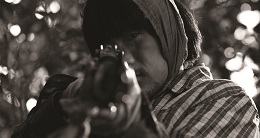
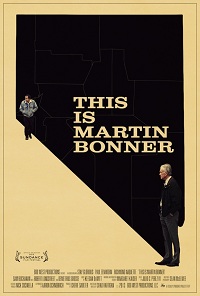
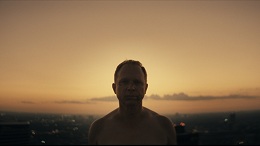
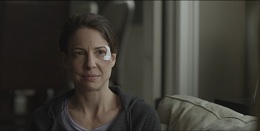


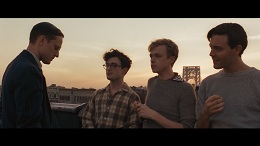
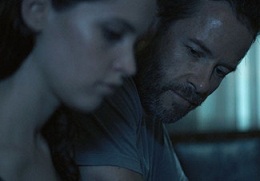
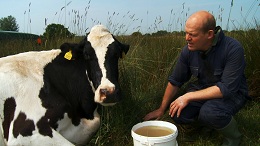

Comments on this entry are closed.